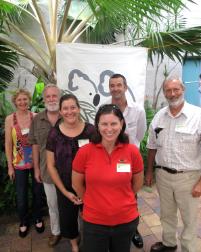Koalas are in desperate trouble and likely to be listed as threatened
Published on 03 February, 2012
Koalas are in desperate trouble and are likely to be listed as threatened by the Commonwealth - but there are no 'one size fits all' solutions.
The threatening processes, ecology and knowledge of koalas are as patchy as the distribution of the species. However, there is abundant evidence that the koala is in serious trouble and does pass the threshold for listing as a threatened species. It's likely that Minister Tony Burke will determine the EPBC Act listing in a decision due on February 17.
That's according to Dr Frank Carrick AM from the University of Queensland's Koala Study Program, who was this week joining discussions for the three-day Central Queensland Koala Workshop.
Hosted at CQUniversity Rockhampton, the forum involves around 40 leading local, national and international koala experts.
LINK for more background, photos and audio from the ABC online coverage of Koala workshops at CQUniversity or
LINK for Koala researchers reveal CQ region hotspots and coldspots
"Having provided evidence at the Melbourne hearing of the Senate Committee, made various additional submissions and having followed its deliberations and the unanimous report, I have to say the Senators ‘got it right' - basically the Committee has strongly urged Tony Burke to list the koala as threatened under the EPBC Act and has pointed out inconsistencies/inaccuracies in the Threatened Species Advisory Committee's (TSSC) previous advice to the Minister," Dr Carrick says.
"The Queensland Government is going to look pretty silly if it has to 'play catch up' with the Feds, since the key elements leading to the likely Commonwealth listing are based on Queensland research.
"In the unlikely event that Commonwealth listing does not happen, it will clearly demonstrate the complete inadequacy of the EPBC Act to protect Australia's unique fauna before it teeters on the very brink of extinction and thus will provide the impetus to develop a national 'Koala Conservation Act' that will actually help protect this national and international iconic species."
Dr Carrick noted that before human beings arrived on our continent, koalas once lived in parts of all of what are now the mainland States. His national perspective update on the status of koalas in 2012 included the following:
WA - there are actually koalas back at Yanchep where fossils of their ancestors were discovered in a cave about 50 years ago - but these are ‘ex pats' from the East and are essentially a zoo population.
SA - All the present koalas here are also ‘ex pats', though free-ranging. Due to their depauperate genetic origins, they make a very limited contribution to the evolutionary potential of the species and their issues are largely those of managing a species outside its natural range.
VIC - The koala now occurs over most of its pre-European-occupation range, BUT its distribution is highly fragmented and much of the population is probably biologically unstable due to the near extinction bottleneck and the unintended consequences of large scale translocation of koalas.
NSW - The koala is almost extinct in the southern half of NSW and in diabolical trouble in the north-eastern parts of its range; several populations are listed as ‘Endangered' and a number have been monitored as they became locally extinct - but one western population has shown us that despite all the other pressures, habitat restoration on a large scale can bring a population back from its descent into the "extinction vortex".
QLD -Although the Queensland populations are also in desperate trouble, this is where the majority of the evolutionary potential of the species resides - thus it is especially important to secure the future of Queensland's official faunal emblem. It is also a microcosm of the overall national situation: the ecology of the species is quite different in the south-eastern corner, the western regions, the dry tropics and the wet tropics of this State; so are the threatening processes, the precision of our knowledge and the amount of management attention.
The contemporary Queensland scene: The most comprehensive data that exist for any koala population are derived from studies of the high density SEQ populations. There is clear evidence that the coastal SEQ koala populations meet the IUCN criteria for listing as ‘Critically Endangered' and the Nature Conservation Act criteria for listing as ‘Endangered Wildlife' - despite nominations for such listing in the second half of 2010 there has been a deafening silence from the Queensland authorities and procrastination by the Commonwealth. Our knowledge of the western and northern populations is less complete but nonetheless clearly demonstrates that there are serious problems for the species here too - consolidating our knowledge and identifying major deficiencies that need to be made good urgently, are the raisons d'etre for this Koala Workshop in Rockhampton hosted by the Central Queensland Koala Research Centre.


